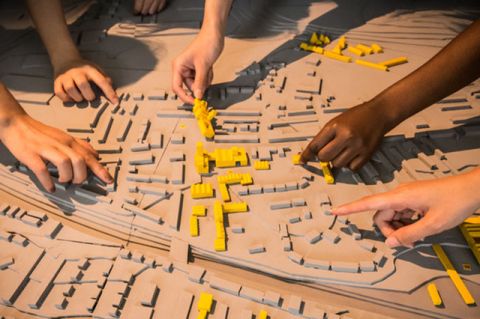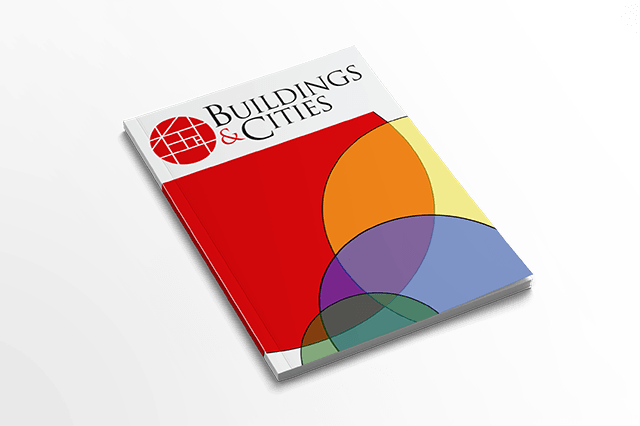Calls for Papers

Guest editors: Alison Kwok (University of Oregon) and Fionn Stevenson (University of Sheffield)
Abstract submissions closed on 07 November 2019.
Built environment education is at a critical juncture to ensure that the workforce has the capacities and capabilities to rapidly decarbonise built environments and reduce environmental degradation, for both new construction and the existing building stock. A rapid transition is needed in universities and training colleges in order to address the Climate Emergency by equipping students and existing professionals / workers with new knowledge and skills. Currently, a workforce without the appropriate low-carbon skills at national and global levels is delivering immediate and long-term negative consequences due to the longevity of buildings, infrastructures and cities. The decisions and designs made now and over the next few years will continue to impact for 60+ years.
The present systems of professional and vocational knowledge creation and transfer (which varies considerably from country to country and program to program) need to be challenged to produce very different forms of interdisciplinary and disciplinary knowledge and skills. Opportunities for synchronicity and rapid propulsion need developing – both within disciplinary boundaries and between disciplines.
To address this sense of extreme urgency, this special issue will examine key questions and offer solutions for educational and training pedagogies, curricula and other practices for the many different built environment disciplines / trades. How can education and training be rapidly changed to ensure the creation of zero-carbon built environments? How can this transition be implemented successfully? What positive examples and models can be drawn upon or adapted? Key topics are: mainstreaming, policy and leadership, transitioning, teaching, upskilling and certification.
More
Guest editor: Thomas Lützkendorf (Karlsruhe Institute of Technology, Germany)
Abstract submissions closed on 26 September 2019.
The built environment’s types and ranges of contributions to greenhouse gas (GHG) emissions and thus to climate change are well known. There is acceptance of the need to drastically reduce GHG emissions and that the built environment must have a significant role. The focus of this special issue is to go substantially beyond the calculation of embodied and lifetime energy / CO2, to explore the appropriate units of assessment and their scalability for each country’s / region’s built environment in relation to the Nationally Determined Contributions (NDCs) and the more recent commitment to limiting global warming to 1.5 C or less.
What is currently lacking is a consistent, robust basis for GHG / carbon metrics associated with the built environment. The development and application of life cycle analysis and sustainability assessments have led to numerous initiatives. Terms, concepts, guidelines, databases and tools nowadays proliferate in a seemingly endless variety. Clarity and consistency are needed on boundary definitions. Although carbon metrics exist they deserve further scrutiny and development to create a next generation of metrics. Although carbon metrics have been the subject of scientific discussion in the past, their results should now become a reliable and directional basis for real decisions.
The aim of this special issue is to develop a common basis for the identification and assessment of GHG emissions in the context of the different scales of the built environment (city, building stocks, neighbourhood, individual building). It will also present possible applications and opportunities, address methodological questions, improve transparency and provide impetus for public policies. Possible topics include: different approaches and trends in environmental performance, methodological questions, data quality, standardization, legislation and governance, forms of communication.
More
Guest editors: Anna Mavrogianni (University College London) and Sonja Klinsky (Arizona State University)
Special issue published 14 July 2020:
What are the influences and roles of buildings, neighbourhoods, communities and urban design in the context of ongoing and anticipated future anthropogenic climate change? How does the design and operation of the built environment under changing circumstances exacerbate or alleviate inequities and vulnerabilities, particularly for low-income communities? Insufficient capacity for climate change adaptation and unequal distribution of resources will negatively affect the achievement of the UN’s Sustainable Development Goals promoting the wellbeing of people in developing countries and low-income communities within wealthy countries.
As the built environment is at the heart of the lives of people and communities, a deeper understanding of the justice implications of efforts to change or maintain the built environment in the context of climate change is essential.
This Special Issue will specifically explore the roles that the different scales of the built environment play in the climate change and inequity nexus. It seeks to examine the full implications of the built environment on social inequities and human development in the context of climate change: how might climate change or climate policies exacerbate these problems, what the scale of this is likely to be, and what policies, strategy solutions, resources and capabilities may be required to manage these concerns within and between countries.
MoreLatest Peer-Reviewed Journal Content
Acceptability of sufficiency consumption policies by Finnish households
E Nuorivaara & S Ahvenharju
Key factors for revitalising heritage buildings through adaptive reuse
É Savoie, J P Sapinski & A-M Laroche
Cooler streets for a cycleable city: assessing policy alignment
C Tang & J Bush
Understanding the embodied carbon credentials of modern methods of construction
R O’Hegarty, A McCarthy, J O’Hagan, T Thanapornpakornsin, S Raffoul & O Kinnane
The changing typology of urban apartment buildings in Aurinkolahti
S Meriläinen & A Tervo
Embodied climate impacts in urban development: a neighbourhood case study
S Sjökvist, N Francart, M Balouktsi & H Birgisdottir
Environmental effects of urban wind energy harvesting: a review
I Tsionas, M laguno-Munitxa & A Stephan
Office environment and employee differences by company health management certification
S Arata, M Sugiuchi, T Ikaga, Y Shiraishi, T Hayashi, S Ando & S Kawakubo
Spatiotemporal evaluation of embodied carbon in urban residential development
I Talvitie, A Amiri & S Junnila
Energy sufficiency in buildings and cities: current research, future directions [editorial]
M Sahakian, T Fawcett & S Darby
Sufficiency, consumption patterns and limits: a survey of French households
J Bouillet & C Grandclément
Health inequalities and indoor environments: research challenges and priorities [editorial]
M Ucci & A Mavrogianni
Operationalising energy sufficiency for low-carbon built environments in urbanising India
A B Lall & G Sethi
Promoting practices of sufficiency: reprogramming resource-intensive material arrangements
T H Christensen, L K Aagaard, A K Juvik, C Samson & K Gram-Hanssen
Culture change in the UK construction industry: an anthropological perspective
I Tellam
Are people willing to share living space? Household preferences in Finland
E Ruokamo, E Kylkilahti, M Lettenmeier & A Toppinen
Towards urban LCA: examining densification alternatives for a residential neighbourhood
M Moisio, E Salmio, T Kaasalainen, S Huuhka, A Räsänen, J Lahdensivu, M Leppänen & P Kuula
A population-level framework to estimate unequal exposure to indoor heat and air pollution
R Cole, C H Simpson, L Ferguson, P Symonds, J Taylor, C Heaviside, P Murage, H L Macintyre, S Hajat, A Mavrogianni & M Davies
Finnish glazed balconies: residents’ experience, wellbeing and use
L Jegard, R Castaño-Rosa, S Kilpeläinen & S Pelsmakers
Modelling Nigerian residential dwellings: bottom-up approach and scenario analysis
C C Nwagwu, S Akin & E G Hertwich
Mapping municipal land policies: applications of flexible zoning for densification
V Götze, J-D Gerber & M Jehling
Energy sufficiency and recognition justice: a study of household consumption
A Guilbert
Linking housing, socio-demographic, environmental and mental health data at scale
P Symonds, C H Simpson, G Petrou, L Ferguson, A Mavrogianni & M Davies
Measuring health inequities due to housing characteristics
K Govertsen & M Kane
Provide or prevent? Exploring sufficiency imaginaries within Danish systems of provision
L K Aagaard & T H Christensen
Imagining sufficiency through collective changes as satisfiers
O Moynat & M Sahakian
US urban land-use reform: a strategy for energy sufficiency
Z M Subin, J Lombardi, R Muralidharan, J Korn, J Malik, T Pullen, M Wei & T Hong
Mapping supply chains for energy retrofit
F Wade & Y Han
Operationalising building-related energy sufficiency measures in SMEs
I Fouiteh, J D Cabrera Santelices, A Susini & M K Patel
Promoting neighbourhood sharing: infrastructures of convenience and community
A Huber, H Heinrichs & M Jaeger-Erben
New insights into thermal comfort sufficiency in dwellings
G van Moeseke, D de Grave, A Anciaux, J Sobczak & G Wallenborn
‘Rightsize’: a housing design game for spatial and energy sufficiency
P Graham, P Nourian, E Warwick & M Gath-Morad
Implementing housing policies for a sufficient lifestyle
M Bagheri, L Roth, L Siebke, C Rohde & H-J Linke
The jobs of climate adaptation
T Denham, L Rickards & O Ajulo
Structural barriers to sufficiency: the contribution of research on elites
M Koch, K Emilsson, J Lee & H Johansson
Disrupting the imaginaries of urban action to deliver just adaptation [editorial]
V Castán-Broto, M Olazabal & G Ziervogel
Nature for resilience reconfigured: global- to-local translation of frames in Africa
K Rochell, H Bulkeley & H Runhaar
How hegemonic discourses of sustainability influence urban climate action
V Castán Broto, L Westman & P Huang
Fabric first: is it still the right approach?
N Eyre, T Fawcett, M Topouzi, G Killip, T Oreszczyn, K Jenkinson & J Rosenow
Social value of the built environment [editorial]
F Samuel & K Watson
Understanding demolition [editorial]
S Huuhka
Data politics in the built environment [editorial]
A Karvonen & T Hargreaves

Latest Commentaries
Integrating Nature into Cities
Increasing vegetation and green and blue spaces in cities can support both climate change mitigation and adaptation goals, while also enhancing biodiversity and ecological health. Maibritt Pedersen Zari (Auckland University of Technology) explains why nature-based solutions (NbS) must be a vital part of urban planning and design.
Co-ordinate Built Environment Research for the Public Good
Gavin Killip and Kate Simpson (Nottingham Trent University) propose a coordinated research programme of field trials to create a focus for iterative learning about outcomes in the built environment, for the public good. They explain why a transdisciplinary programme is needed and seven key characteristics of the programme are proposed.